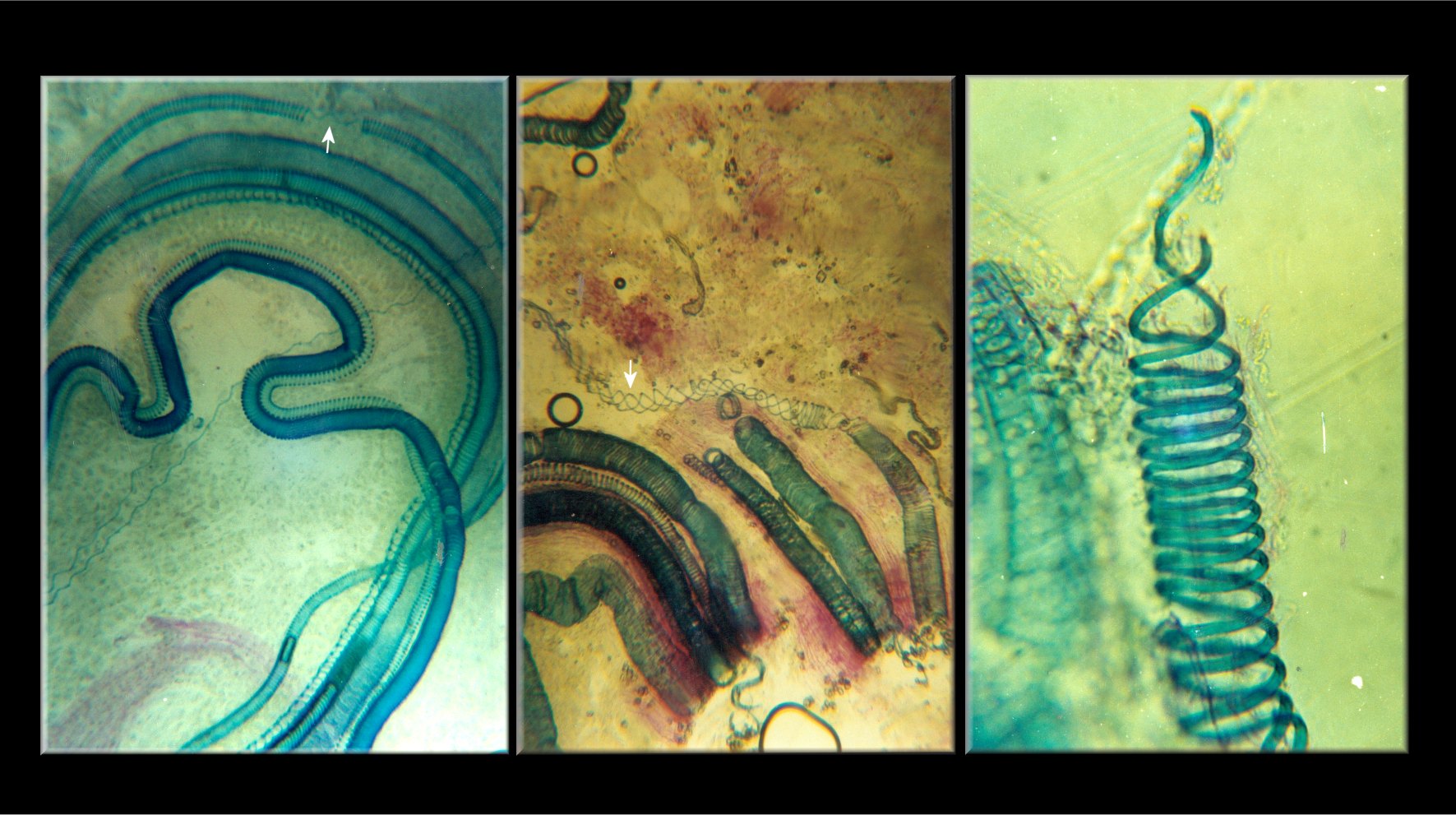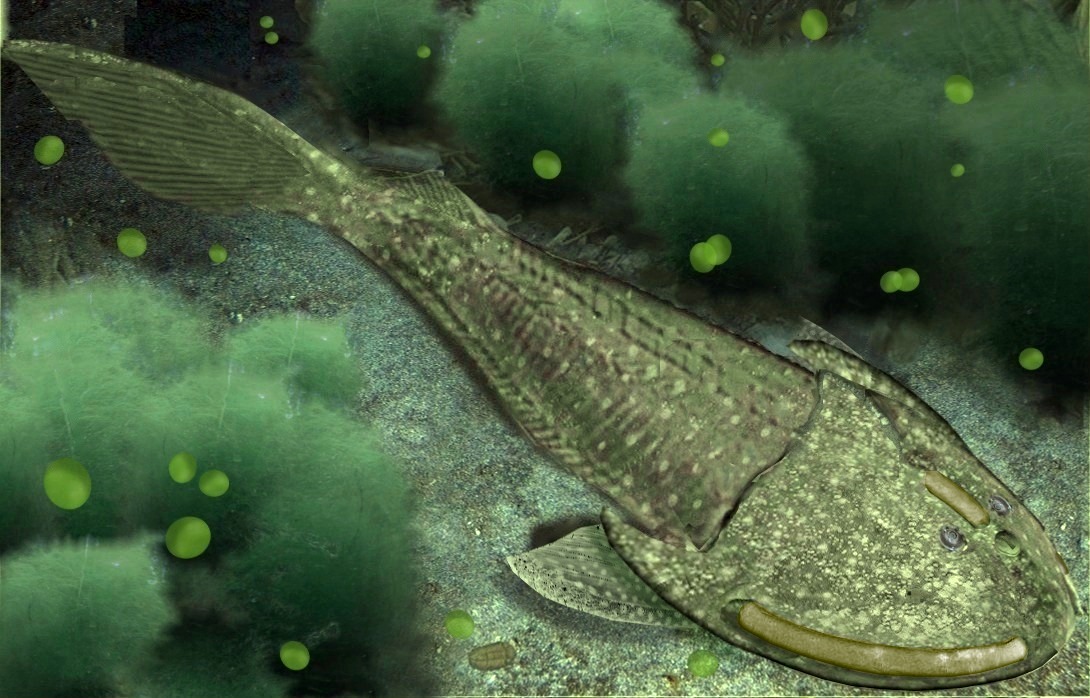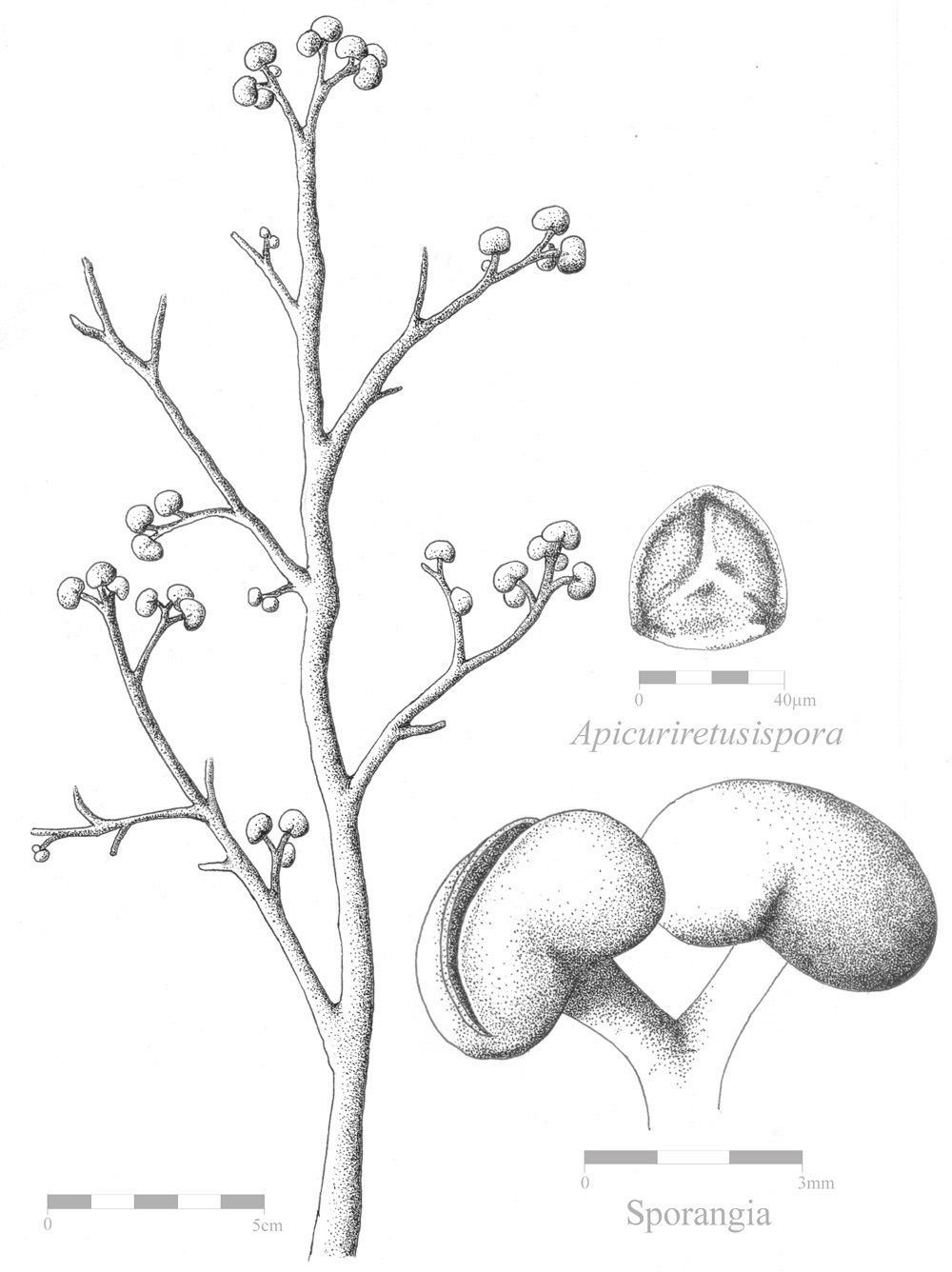|
Sawdonia Ornata
Sawdonia is an extinct genus of early vascular plants, known from the Upper Silurian to the Lower Carboniferous (). ''Sawdonia'' is best recognized by the large number of spikes ( enations) covering the plant. These are vascular plants that do not have vascular systems in their enations. The first species of this genus (''Sawdonia ornata'') was described in 1859 by Sir J. William Dawson and, was originally attributed to the genus '' Psilophyton''. He named this plant ''Psilophyton princeps''. In 1971 Francis Hueber proposed a new genus for this species due to its "Divergent technical characters from the generic description for ''Psilophyton''." The holotype used for description is Dawson Collection Number 48, pro parte, Museum Specimen Number 3243. (See Dawson 1871, Plate IX, fig 101.) Sir J. William Dawson Collection, Peter Redpath Museum, McGill University, Montreal, Quebec, Canada. Morphology These plants are described by Hueber as having monopodially branched stems, that a ... [...More Info...] [...Related Items...] OR: [Wikipedia] [Google] [Baidu] |
Vascular Plant
Vascular plants (), also called tracheophytes () or collectively Tracheophyta (), form a large group of land plants ( accepted known species) that have lignified tissues (the xylem) for conducting water and minerals throughout the plant. They also have a specialized non-lignified tissue (the phloem) to conduct products of photosynthesis. Vascular plants include the clubmosses, horsetails, ferns, gymnosperms (including conifers), and angiosperms (flowering plants). Scientific names for the group include Tracheophyta, Tracheobionta and Equisetopsida ''sensu lato''. Some early land plants (the rhyniophytes) had less developed vascular tissue; the term eutracheophyte has been used for all other vascular plants, including all living ones. Historically, vascular plants were known as "higher plants", as it was believed that they were further evolved than other plants due to being more complex organisms. However, this is an antiquated remnant of the obsolete scala naturae, an ... [...More Info...] [...Related Items...] OR: [Wikipedia] [Google] [Baidu] |
Gosslingiales
Gosslingiales is an order of extinct zosterophylls. The zosterophylls were among the first vascular plants in the fossil record, and share an ancestor with the living lycophytes. The group has been divided up in various ways. Hao and Xue in 2013 used the presence or absence of terminal sporangia as a major dividing feature. The order Zosterophyllales was used for species with terminal as well as lateral sporangia, which were considered to have determinate growth, with their sporangia generally being arranged in spikes. The paraphyletic order Gosslingiales was used for species without terminal sporangia (i.e. with only lateral sporangia), which were considered to have indeterminate growth, with fertile branches generally circinate (initially curled up). Species assignable to the Gosslingiales made up about 9% of all confirmed species in the Early Devonian flora. Taxonomy Classification Hao and Xue consider the order Gosslingiales to be one of the two major divisions of the zoste ... [...More Info...] [...Related Items...] OR: [Wikipedia] [Google] [Baidu] |
Paleozoic Life Of Quebec
The Paleozoic (or Palaeozoic) Era is the earliest of three era (geology), geologic eras of the Phanerozoic Eon. The name ''Paleozoic'' ( ;) was coined by the British geologist Adam Sedgwick in 1838 by combining the Ancient Greek, Greek words ''palaiós'' (, "old") and ''zōḗ'' (), "life", meaning "ancient life" ). It is the longest of the Phanerozoic eras, lasting from , and is subdivided into six period (geology), geologic periods (from oldest to youngest): # Cambrian # Ordovician # Silurian # Devonian # Carboniferous # Permian The Paleozoic comes after the Neoproterozoic Era of the Proterozoic Eon and is followed by the Mesozoic Era. The Paleozoic was a time of dramatic geological, climatic, and evolutionary change. The Cambrian witnessed the most rapid and widespread diversification of life in Earth's history, known as the Cambrian explosion, in which most modern phylum, phyla first appeared. Arthropods, Mollusca, molluscs, fish, amphibians, reptiles, and synapsids all ... [...More Info...] [...Related Items...] OR: [Wikipedia] [Google] [Baidu] |
Paleozoic Life Of Ontario
The Paleozoic (or Palaeozoic) Era is the earliest of three geologic eras of the Phanerozoic Eon. The name ''Paleozoic'' ( ;) was coined by the British geologist Adam Sedgwick in 1838 by combining the Greek words ''palaiós'' (, "old") and ''zōḗ'' (), "life", meaning "ancient life" ). It is the longest of the Phanerozoic eras, lasting from , and is subdivided into six geologic periods (from oldest to youngest): # Cambrian # Ordovician # Silurian # Devonian # Carboniferous # Permian The Paleozoic comes after the Neoproterozoic Era of the Proterozoic Eon and is followed by the Mesozoic Era. The Paleozoic was a time of dramatic geological, climatic, and evolutionary change. The Cambrian witnessed the most rapid and widespread diversification of life in Earth's history, known as the Cambrian explosion, in which most modern phyla first appeared. Arthropods, molluscs, fish, amphibians, reptiles, and synapsids all evolved during the Paleozoic. Life began in the ocean but e ... [...More Info...] [...Related Items...] OR: [Wikipedia] [Google] [Baidu] |
Strathmore Group
The Strathmore Group is a Devonian lithostratigraphic group (a sequence of rock strata) in central Scotland. Its sandstones are interbedded with siltstones which interfinger with conglomerates. It is encountered from Arran in the west across the Midland Valley to Stonehaven in the east. The name is derived from Strathmore, Angus where this sequence occupies the axis of the Strathmore Syncline which runs for many tens of miles parallel to and south of the Highland Boundary Fault The Highland Boundary Fault is a major fault zone that traverses Scotland from Arran and Helensburgh on the west coast to Stonehaven in the east. It separates two different geological terranes which give rise to two distinct physiographic ter .... The rocks of the Strathmore Group have also previously been referred to as the Strathmore Beds. References * {{Refend Devonian System of Europe Geology of Scotland Geological groups of the United Kingdom Geologic formations of the United Kingdom [...More Info...] [...Related Items...] OR: [Wikipedia] [Google] [Baidu] |
Scotland
Scotland (, ) is a country that is part of the United Kingdom. Covering the northern third of the island of Great Britain, mainland Scotland has a border with England to the southeast and is otherwise surrounded by the Atlantic Ocean to the north and west, the North Sea to the northeast and east, and the Irish Sea to the south. It also contains more than 790 islands, principally in the archipelagos of the Hebrides and the Northern Isles. Most of the population, including the capital Edinburgh, is concentrated in the Central Belt—the plain between the Scottish Highlands and the Southern Uplands—in the Scottish Lowlands. Scotland is divided into 32 administrative subdivisions or local authorities, known as council areas. Glasgow City is the largest council area in terms of population, with Highland being the largest in terms of area. Limited self-governing power, covering matters such as education, social services and roads and transportation, is devolved from the ... [...More Info...] [...Related Items...] OR: [Wikipedia] [Google] [Baidu] |
England
England is a country that is part of the United Kingdom. It shares land borders with Wales to its west and Scotland to its north. The Irish Sea lies northwest and the Celtic Sea to the southwest. It is separated from continental Europe by the North Sea to the east and the English Channel to the south. The country covers five-eighths of the island of Great Britain, which lies in the North Atlantic, and includes over 100 smaller islands, such as the Isles of Scilly and the Isle of Wight. The area now called England was first inhabited by modern humans during the Upper Paleolithic period, but takes its name from the Angles, a Germanic tribe deriving its name from the Anglia peninsula, who settled during the 5th and 6th centuries. England became a unified state in the 10th century and has had a significant cultural and legal impact on the wider world since the Age of Discovery, which began during the 15th century. The English language, the Anglican Church, and Eng ... [...More Info...] [...Related Items...] OR: [Wikipedia] [Google] [Baidu] |
Campo Chico Formation
Campo may refer to: Places ;Cameroon * Campo, Cameroon, in the South Province ;Equatorial Guinea * Río Campo, in the Litoral Province ;France * Campo, Corse-du-Sud, a commune on the island of Corsica ;Italy * Campo P.G., a World War II prisoner-of-war camp * Campo, Cortina d'Ampezzo, a ''frazione'' in the province of Belluno, Veneto * Campo, San Giuliano Terme, a ''frazione'' in the province of Pisa, Tuscany * Campo (Venice), a type of square ;Portugal * Campo (Reguengos de Monsaraz), a parish in the municipality of Reguengos de Monsaraz * Campo (São Martinho), a former civil parish in the municipality of Santo Tirso * Campo (Valongo), a parish in the municipality of Valongo * Campo (Viseu), a parish in the municipality of Viseu * Campo e Tamel (São Pedro Fins), a civil parish in the municipality of Barcelos ;Spain * Campo, Spain, a municipality in the province of Huesca ;Switzerland * Campo, Vallemaggia, a municipality in the district of Vallemaggia in the canton of Ticino ... [...More Info...] [...Related Items...] OR: [Wikipedia] [Google] [Baidu] |
Venezuela
Venezuela (; ), officially the Bolivarian Republic of Venezuela ( es, link=no, República Bolivariana de Venezuela), is a country on the northern coast of South America, consisting of a continental landmass and many islands and islets in the Caribbean Sea. It has a territorial extension of , and its population was estimated at 29 million in 2022. The capital and largest urban agglomeration is the city of Caracas. The continental territory is bordered on the north by the Caribbean Sea and the Atlantic Ocean, on the west by Colombia, Brazil on the south, Trinidad and Tobago to the north-east and on the east by Guyana. The Venezuelan government maintains a claim against Guyana to Guayana Esequiba. Venezuela is a federal presidential republic consisting of 23 states, the Capital District and federal dependencies covering Venezuela's offshore islands. Venezuela is among the most urbanized countries in Latin America; the vast majority of Venezuelans live in the cities of ... [...More Info...] [...Related Items...] OR: [Wikipedia] [Google] [Baidu] |
Battery Point Formation
The Battery Point Formation is a geologic formation in Quebec. It preserves fossils dating back to the early Emsian to early Eifelian the lower Devonian period. Description A part of the Gaspé Sandstones, the Battery Point Formation is believed to have been deposited in a fluvial environment based on the presence of rootlets as well as the abundance of trough and planar-tabular cross bedding, and the lower part resembles modern braided systems more than meandering systems. It rests unconformably on the shallow marine sandstones of the York River Formation (the basal unit of the Gaspé Sandstones and making the Battery Point Formation the first continental unit of the sequence), transitioning upwards into the Malbaie Formation, and is 2,300 meters (7,550 feet) thick. Fossil content Limited intervals in the lower part of the formation contain remains of a few brachiopods and bivalves Bivalvia (), in previous centuries referred to as the Lamellibranchiata and Pelecypoda, ... [...More Info...] [...Related Items...] OR: [Wikipedia] [Google] [Baidu] |
Canada
Canada is a country in North America. Its ten provinces and three territories extend from the Atlantic Ocean to the Pacific Ocean and northward into the Arctic Ocean, covering over , making it the world's second-largest country by total area. Its southern and western border with the United States, stretching , is the world's longest binational land border. Canada's capital is Ottawa, and its three largest metropolitan areas are Toronto, Montreal, and Vancouver. Indigenous peoples have continuously inhabited what is now Canada for thousands of years. Beginning in the 16th century, British and French expeditions explored and later settled along the Atlantic coast. As a consequence of various armed conflicts, France ceded nearly all of its colonies in North America in 1763. In 1867, with the union of three British North American colonies through Confederation, Canada was formed as a federal dominion of four provinces. This began an accretion of provinces and ... [...More Info...] [...Related Items...] OR: [Wikipedia] [Google] [Baidu] |
Gosslingiaceae
Gosslingiaceae is a family of extinct zosterophylls. The zosterophylls were among the first vascular plants in the fossil record, and are considered to share an ancestor with the living lycophytes. The family is variously placed in the order Sawdoniales or the order Gosslingiales Gosslingiales is an order of extinct zosterophylls. The zosterophylls were among the first vascular plants in the fossil record, and share an ancestor with the living lycophytes. The group has been divided up in various ways. Hao and Xue in 201 .... Genera Genera that have been placed in this family by Kenrick and Crane in 1997 and Hao and Xue in 2013 are shown in the table below. References Zosterophylls Prehistoric plant families {{paleobotany-stub ... [...More Info...] [...Related Items...] OR: [Wikipedia] [Google] [Baidu] |





